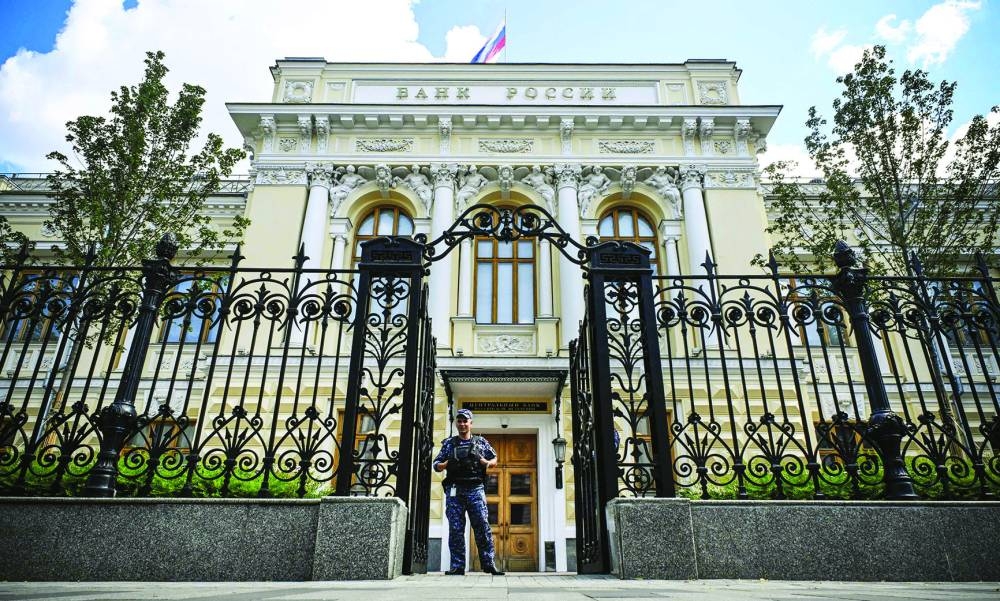Russia raised interest rates for the first time since emergency measures taken after the invasion of Ukraine almost 17 months ago, delivering a bigger increase than forecast by economists and signalling borrowing costs may rise higher still.The central bank yesterday lifted its benchmark to 8.5% from 7.5%, more than any forecast in a Bloomberg survey. Speaking after the meeting in Moscow, Governor Elvira Nabiullina said the board of directors considered increases of 75 and 100 basis points, and the magnitude of its future steps will depend on incoming data and how the economy reacts to monetary tightening. “At the coming meetings, we allow for the possibility of a further increase in the key rate,” she said.
A weaker rouble accelerated the timeline for monetary tightening after months of warnings by the central bank that higher rates were on the way in response to inflationary risks from heavy government spending, sanctions and labour shortages caused by the call-up of men to fight in Ukraine.
A failed mutiny in June further thrust the rouble into the spotlight by adding to pressure from a deterioration in foreign trade that’s turned it into one of the worst performers this year in emerging markets against the dollar. The rouble traded about 0.2% weaker versus the dollar after the announcement yesterday.
“The central bank is trying to contain the crumbling of the rouble, and this increase isn’t the last one,” said Natalia Milchakova, an analyst at Freedom Finance. “A return to loose monetary policy will most likely not be possible until the second half of 2024.”
The decision to lift rates ends the longest pause in more than seven years by the central bank, which hasn’t adjusted rates since six rounds of easing ended in September. It last hiked the benchmark days after the invasion with an emergency increase to 20%, the highest in almost two decades, as unprecedented international sanctions battered Russia’s economy and assets.
In their statement, policymakers said price growth is currently running above 4% in annualised terms and is “still on the rise.” The central bank tweaked its forecast for inflation and now predicts it will end the year at 5-6.5%. “The increase in domestic demand surpasses the capacity to expand production, including due to the limited availability of labour resources,” it said. “This reinforces persistent inflationary pressure in the economy.”
“The Bank of Russia’s bold move to raise its key rate by 100 basis point is likely to support Russia’s weakening currency and reduce credit growth. Prior to today’s increase, the rate was probably too low to stem rising capital outflows and keep inflation around its 4% target. We don’t expect the Bank of Russia to stop at one hike, but neither do we see this (mini-)hiking cycle taking the policy rate above 10%,” says Alexander Isakov, Russia economist.
The armed rebellion by Wagner mercenaries that briefly threatened President Vladimir Putin’s power carries the risk of triggering further outflows of money at a time when falling energy earnings and a recovery in imports drain the economy of hard currency.
It’s a prospect that could be a drag on the rouble in the months to come. The Russian currency has already lost about 18% this year, with more than a third of the depreciation coming after Wagner’s attempted march to Moscow. Three-month implied volatility for the currency, a gauge of anticipated moves, is also the world’s highest. “Given the changes in our assessment of the economic situation, a higher key rate trajectory will be required for us to end next year with inflation on target near 4%,” Nabiullina said.
Though the governor has called the rouble’s floating exchange rate “a blessing” for the economy, the currency’s retreat is making imports more expensive.
The central bank still expects to meet its 4% target for inflation next year, according to an updated outlook published yesterday, which included an improved forecast for economic growth in 2023. “The economy has in general completed its recovery phase,” the central bank said. “In the future, the economy’s growth rates will gradually converge towards the rates that are consistent with a balanced growth path.”

A police officer guards the entrance of the Russian central bank headquarters in downtown Moscow. Russia raised interest rates for the first time since emergency measures taken after the invasion of Ukraine almost 17 months ago, delivering a bigger increase than forecast by economists and signalling borrowing costs may rise higher still.
